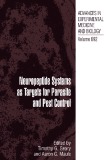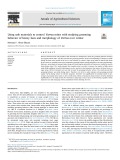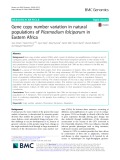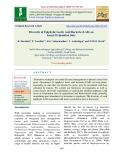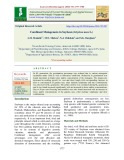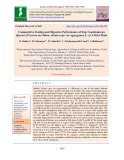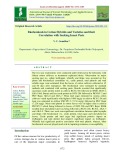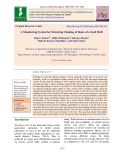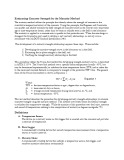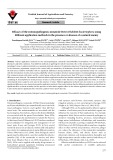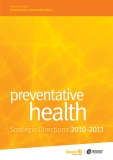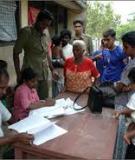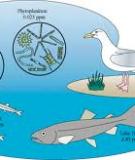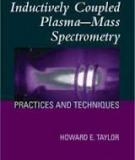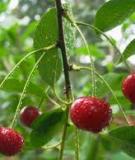
The laboratory or in the field
-
Ebook "Neuropeptide systems as targets for parasite and pest control" was assembled to focus attention on this promising field by compiling a comprehensive review of recent research on neuropeptides in arthropods and helminths, with contributions from many of the leading laboratories working on these systems. The need to continually discover new agents for the control or treatment of invertebrate pests and pathogens is undeniable. Agriculture, both animal and plant, succeeds only to the extent that arthropod and helminth consumers, vectors and pathogens can be kept at bay.
 246p
246p  cotieubac1004
cotieubac1004
 15-03-2024
15-03-2024
 1
1
 0
0
 Download
Download
-
The results showed that propolis extract was able to increase the number of fallen mites under field conditions but with lethal impacts on bee workers in the laboratory than extract of drone larvae or sugar syrup. All the treatments were not able to boost the grooming behavior of bees. The results proved that grooming behavior was stable during winter
 6p
6p  schindler
schindler
 30-12-2021
30-12-2021
 9
9
 0
0
 Download
Download
-
Gene copy number variants (CNVs), which consist of deletions and amplifications of single or sets of contiguous genes, contribute to the great diversity in the Plasmodium falciparum genome. In vitro studies in the laboratory have revealed their important role in parasite fitness phenotypes such as red cell invasion, transmissibility and cytoadherence. Studies of natural parasite populations indicate that CNVs are also common in the field and thus may facilitate adaptation of the parasite to its local environment.
 15p
15p  vibeauty
vibeauty
 23-10-2021
23-10-2021
 10
10
 0
0
 Download
Download
-
Alternative strategies are needed in pest management to protect crops from pests. Occurrence of epiphytic lactic acid bacteria (LAB) on crop plants, especially on sites that are selected by pests, may be associated with host selection by insects. We carried out laboratory investigations as well as screen house and field experiments to understand whether epiphytic LAB occur at oviposition sites of agricultural and horticultural crops, probably modulating pest abundance by attraction or repulsion. The diversity of such epiphytic LAB associated with insect oviposition sites is discussed.
 15p
15p  nguaconbaynhay5
nguaconbaynhay5
 16-05-2020
16-05-2020
 15
15
 2
2
 Download
Download
-
In M1 generation, the germination percentage was reduced due to various mutagenic treatments under field as well as laboratory conditions. Reduction in germination was found maximum in higher dose and/or concentration of the mutagens. The progressive decreased in seedling growth viz. root and shoot length with corresponding increase in dose or concentration of gamma rays, ethyl methane sulphonate and their combinations was observed in M1 generation.
 4p
4p  angicungduoc4
angicungduoc4
 26-04-2020
26-04-2020
 13
13
 0
0
 Download
Download
-
Shallot, Allium cepa var aggregatum L. (Alliaceae) is one of the major bulbous vegetable grown both as garden and field crop in India. The major leaf feeding insect pests of onion, Spodoptera exigua, Spodoptera litura, Helicoverpa armigera and the recently invasive insect Spodoptera frugiperda were causing destructive damage to the plant and made economic yield loss. Food consumption indices were studied under laboratory condition at room temperature 28 ± 20C and it is one of the parameter to identify the damage potential of insects.
 11p
11p  chauchaungayxua3
chauchaungayxua3
 07-02-2020
07-02-2020
 13
13
 1
1
 Download
Download
-
The two year experiments were conducted under field and in the laboratory with fifteen cotton cultivars as treatments replicated thrice. Observation on major sucking pest viz., aphid, leafhopper, whitefly and thrips were recorded on five plants and biochemical constituent viz., crude protein, total phenols and total soluble sugar were estimated from the leaves of cotton cultivars collected at 45 and 60 days after emergence. The biochemical were estimated by standard methods and correlated with sucking pests.
 12p
12p  nguaconbaynhay3
nguaconbaynhay3
 07-02-2020
07-02-2020
 10
10
 1
1
 Download
Download
-
Choking of seed drill during sowing of wheat generally occurs due to excessive soil moisture, weeds or agricultural residue present in the field. The developed monitoring system for detecting the choking of boot comprised three units: sensing unit, processing unit and alert unit. A direct incidence infrared (IR) emitter and IR receiver were selected for detecting choking of boots of a seed drill.
 11p
11p  nguathienthan2
nguathienthan2
 19-12-2019
19-12-2019
 17
17
 0
0
 Download
Download
-
The working group of G. hirsutum germplasm accessions was characterized for Distinctiveness, Uniformity and Stability testing. Subsequent analysis of data was done to study the genetic diversity available among the accessions using principal component and clustering of 320 cotton germplasm. Under field and laboratory, 26 qualitative traits and 14 quantitative traits were recorded. There is no variation observed for gossypol glands, anther filament colour, male sterility, boll bearing habit and boll opening.
 19p
19p  cothumenhmong1
cothumenhmong1
 08-12-2019
08-12-2019
 19
19
 1
1
 Download
Download
-
The maturity method utilizes the principle that directly relates the strength of concrete to the cumulative temperature history of the concrete. Using this principle, the Engineer and Contractor can quickly and reliably estimate the field strength of concrete based on the maturity index (equivalent age or time-temperature factor) rather than by beam or cylinder tests in the field or the laboratory. The maturity as applied to a concrete mix is specific to that particular mix.
 10p
10p  christian2605
christian2605
 30-10-2019
30-10-2019
 14
14
 1
1
 Download
Download
-
Various application methods for the entomopathogenic nematode Heterorhabditis bacteriophora were evaluated under laboratory and field conditions. Four different methods of applying the infective juveniles (IJs) of the nematode to soil were assessed including insect cadavers (referred to as nematode-infected cadavers), subsurface injection, praying and drip irrigation.
 9p
9p  danhdanh11
danhdanh11
 11-01-2019
11-01-2019
 20
20
 2
2
 Download
Download
-
Thin and thick blood smears were also collected from participants who accepted malaria testing. Blood slides were stained with Giemsa stain that was prepared by the laboratory in advance of the field work. Parasite densities were calculated by counting the number of asexual stage parasites/200 white blood cells (WBCs), assuming 6000 WBCs/dl of blood. Blood smears were considered negative if no parasites were found after counting 200 fields. An informed consent form was read to the eligible person or parent/responsible adult of the child or teenager ages 15-18 years old.
 52p
52p  nhamnhiqa
nhamnhiqa
 01-03-2013
01-03-2013
 43
43
 1
1
 Download
Download
-
The West Pearl Queen reservoir project also used soil gas surveys to detect PFC tracers that were injected into the reservoir with the CO2. Soil gas sampling was conducted before and after the CO2 injection by using capillary tubes and adsorbent packets for the tracers. Brookhaven National Laboratory (BNL) supplied the tracers and performed the tracer concentration analysis (Wells et al., 2007). Near-Surface Geophysics – The use of magnetometers is another possible near-surface geophysical technique.
 140p
140p  bin_pham
bin_pham
 06-02-2013
06-02-2013
 53
53
 4
4
 Download
Download
-
However, few reliable studies have been undertaken to assess the effectiveness of these interventions in the field. Current evidence is insufficient for drawing conclusions about which interventions work in a specific setting, and for making recommendations to local and national policy-makers. Therefore, there is an urgent need to evaluate intervention projects and programmes around the world.
 19p
19p  doipassword
doipassword
 01-02-2013
01-02-2013
 45
45
 3
3
 Download
Download
-
The researchers who choose to work in the field of trace element determinations are not necessarily experienced analytical chemists. However, once involved in this sort of research, they either should acquire the necessary instrumentation in their laboratory or should be able to communicate with their collaborating colleagues who will probably be analytical chemists. In any case, this type of reader will need to know more about analytical che
 362p
362p  doilan
doilan
 26-01-2013
26-01-2013
 67
67
 8
8
 Download
Download
-
Accepted worldwide as one of the most important new areas in clinical dentistry, esthetic dentistry is undergoing constant expansion and advancement. Here is the first complete practitioner's guide to the field, with key techniques for improving, restoring, or rebuilding single teeth with a wide range of ceramic systems. Written by a renowned international team who has pioneered several of the techniques in use today, the book covers both basic principles and clinical and laboratory procedures, with dozens of case examples and before-and-after photographs....
 0p
0p  mnemosyne75
mnemosyne75
 02-02-2013
02-02-2013
 44
44
 5
5
 Download
Download
-
These included the following: (1) obtaining official infor- mation to proceed with the project from the LGA au- thorities; (2) consent of the mothers of under-5 children to fully participate at all stages of the project was obtained; (3) fifty households were selected in a nearby community (Ilaporu) for pre-testing of the questionnaire before large-scale study - the questionnaires were pre- tested with the research assistants, who had debriefing on field experiences and proffered solutions to identified problems - amendments were made, which led to re- designing aspects of the ins...
 8p
8p  chiecxedien
chiecxedien
 03-01-2013
03-01-2013
 52
52
 2
2
 Download
Download
-
Addition of Surrogates and Matrix Spiking Compounds in the Field: It is best to add analytical surrogate and matrix spiking compounds into soils prior to sample extraction, using water or a solvent. Method 5035A does not incorporate the addition of these compounds prior to extraction in the field. Because this is an important control check on the analytical process, it may be appropriate to incorporate a procedure which adds surrogate and/or matrix spiking compounds prior to extraction for some project/program DQOs.
 6p
6p  cao_can
cao_can
 02-01-2013
02-01-2013
 65
65
 3
3
 Download
Download
-
To help ensure accurate measurements, Region 9 recommends that these guidelines be followed whenever VOCs in soil or other solid matrices are sampled and analyzed. These guidelines address methods for: (1) handling of samples as intact soil cores; (2) preserving samples; (3) storing samples in hermetically sealed containers; and (4) minimizing analyte losses due to direct volatilization (both in the field and the laboratory) and biodegradation.
 6p
6p  cao_can
cao_can
 02-01-2013
02-01-2013
 51
51
 4
4
 Download
Download
-
These guidelines address methods for: (1) handling of samples as intact soil cores; (2) preserving samples; (3) storing samples in hermetically sealed containers; and (4) minimizing analyte losses due to direct volatilization (both in the field and the laboratory) and biodegradation. Region 9 believes that following these guidelines is an important part of ensuring that accurate concentrations of VOCs are measured.
 0p
0p  cao_can
cao_can
 02-01-2013
02-01-2013
 43
43
 3
3
 Download
Download








